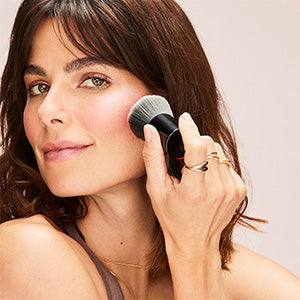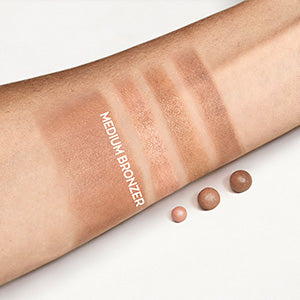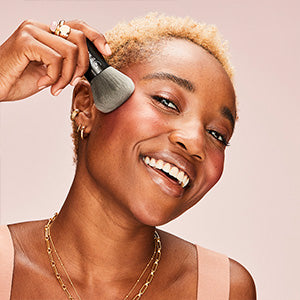Professionally applied blusher can completely transform any makeup look, adding a pop of colour to your face that makes you look more alive, glowy and cheery whatever the weather. Yet learning how to apply it for these results can be hard, and finding the best tones and colours to suit your skin tone and your various outfits can be just as challenging.
In this article, we look at different methods for applying blusher depending on your individual style and face shape, as well as how to find the best products for your skin tone and type.
What colour of blush should I wear?
The right shade from our blusher collection can help make us look more youthful and give our skin a healthy, rosy glow, but if we get it wrong it can actually have the reverse effect and make us look tired and washed out, or if applied too heavily we may even end up resembling a rag doll with overly pigmented cheeks.
Deciding on the right colour blush for your skin tone may take a bit of trial and error, as some products tend to be more pigmented than others. You might also find that, depending on your skin type, certain products sit better on your skin. For example, someone with a dry skin type might prefer cream blush to a powder as it is more moisturising. But luckily we have some helpful pointers to answer the question: 'what colour blush should I wear?' depending on your skin-tone.

Fair Skin Tone
If you have a fair skin tone, we advise that you go for blusher shades that will give you a subtle, natural flush of colour. Try experimenting with some light pinks, peachy shades or light corals. Soft pink shades will help give you a natural flush that makes them ideal for everyday wear, while the brighter peaches and corals are better suited for adding a pop of colour when you're dressing up. For every day, you could try the Blush Pearls, while the Avon True Luminous Blush in shade Peach will look great for nights out on the town.

Medium Skin Tone
Those of us with medium skin tones are spoilt for choice of warm pinks, mauves and rich peach colours. If your skin has golden undertones, try a rich peach colour blush to complement your skin tone and give you a natural glow. If your skin's undertones are cooler, these rich peaches will help add a hit of colour to your look. Try a mauve shade of blush like 2-in-1 Lip & Cheek Cream Blush in Warm Flush for added colour if your skin's undertones are warm, or a natural flush if your medium skin benefits from cooler undertones.

Dark Skin Tone
Darker skin tones benefit from richer colours with pigments of dark red, brown, orange or even purples. Some shades you might want to look out for include tangerines, fuchsias, berries and raisins. Avon 3D Matte Blusher in Plum Pop gives a wonderful deep orangey tone that works wonderfully to brighten the cheeks of those with cooler undertones in their skin. If your undertones are warmer, wear it on your cheekbones for a natural hue.
Where to apply blush
Once you have found the best blusher tone for your skin, knowing exactly where to put blush and how to apply it to your face are the next important steps. Depending on the product you are using, you may wish to apply your blush with a bronzer brush, a makeup sponge, or even just your fingertips.
We will discuss the tools and methods of applying blush later on. For now, we need to take a look at how your face shape can determine the best place for you to apply blush to your face. To do this, you will first need to decide whether your face is heart-shaped, oval, triangular, oblong/long, square or round. To do this, the best method is to tie your hair up and sit in front of a mirror. Next, trace your face shape onto the mirror using a non-permanent marker pen. Compare your drawing to the descriptions below.
How to apply blush to a heart-shaped face
You may not be surprised to hear that heart-shaped faces look a little bit like a heart. To determine whether you have a heart-shaped face, you will notice that your forehead is wide, your cheekbones are high, and your face then angles into a point at your chin.
If you have a heart-shaped face, you may want to soften the points of your cheeks with a blusher. To do this, you can apply a little blush to your temples, a little like you might if you were contouring your face. When applying blush to your cheeks, start at the inner lower corner of your cheekbones and sweep up and outwards using light strokes towards the outer corners of your eyes.

How to apply blush to an oval face
Oval face shapes have quite rounded chins that are slightly narrower than the forehead. To help give your face structure more definition, sweep blush just above the top of your cheekbones to make your cheekbones appear higher on your face.
How to apply blush to a triangular face
Sometimes confused with a heart-shaped face, triangular face shapes have very pointed chins that angle straight up to meet the cheekbones. To balance out the width of your face, applying a blusher in a triangular shape on each cheek will help. Starting at the points of your cheek nearest the corners of your mouth, apply your blusher upwards and outwards to just past the corners of your eyes, then join up the triangles at the inner upper part of your cheek. Do not apply to the under-eye area, if you find yourself adding blusher here you have gone too high on your face.
How to apply blush to an oval face
Oval face shapes have quite rounded chins that are slightly narrower than the forehead. To help give your face structure more definition, sweep blush just above the top of your cheekbones to make your cheekbones appear higher on your face.
How to apply blush to a triangular face
Sometimes confused with a heart-shaped face, triangular face shapes have very pointed chins that angle straight up to meet the cheekbones. To balance out the width of your face, applying a blusher in a triangular shape on each cheek will help. Starting at the points of your cheek nearest the corners of your mouth, apply your blusher upwards and outwards to just past the corners of your eyes, then join up the triangles at the inner upper part of your cheek. Do not apply to the under-eye area, if you find yourself adding blusher here you have gone too high on your face.
How to apply blush to an oblong or long face
Also known as a 'rectangular' face, an oblong face is longer than a square or oval-shaped face, and the forehead, jawline and cheeks are about as wide as each other. To help your face appear shorter, apply a light application of blush along the top of your cheekbones and extend this down your cheeks until it comes in line with a centimetre or two above the tip of your nose.

How to apply blush to a square face
Square shaped faces are relatively short in length, with cheekbones, forehead and chin roughly the same width. If you have the strong features of a square face, you can likely pull off deeper blushes. Try stippling colour slightly below your cheekbones and up and out towards the outer corners of your eyes. You can also apply a little blush to your hairline to soften the angles of your face.

How to apply blush to a round face
The best way to determine whether your face is square or round is to look for angles in your jawline. If you have a rounded jawline and your face is roughly as wide as it is long, your face is round. If you have a round face, avoid reflective pigments that may make your face appear more spherical. Instead, opt for matte shades, and starting on the apples of the cheeks, sweep your blusher upwards and outwards towards the tops of your ears to give your facelift. Contouring your cheeks and adding a little blush to your chin will also help elongate your features.
What is the best blush makeup brush to buy?
The best blush makeup application tool will depend on the product you are using. If you are using a liquid or cream blush, you may wish to apply it with your fingers first then blend it out with a makeup sponge.
For powder blush, however, you will likely be best off with a brush such as this Angled Blush Brush. The angled element to this brush makes it popular with makeup artists for helping give dimension and depth to the face.
How can I use lipstick as a blush?
Yes, it is also possible to use lipstick as a blush! Choose your favourite shade of matte lipstick, draw faint lines of it onto your cheekbones and blend this in with a brush.
Once you've perfected your blusher for day and night looks, don't forget to remove your makeup properly using a muslin cloth and makeup remover. This will prevent your pores from becoming clogged, and keep your complexion smooth and blemish-free.